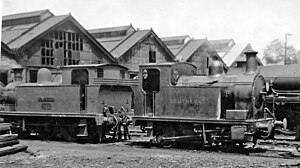LSWR S14 class
| LSWR C14 & S14 Classes | |||||||||||||||||||||||||||
|---|---|---|---|---|---|---|---|---|---|---|---|---|---|---|---|---|---|---|---|---|---|---|---|---|---|---|---|

C14 0-4-0T No. 3744 at Eastleigh Locomotive Depot 1946
|
|||||||||||||||||||||||||||
|
|||||||||||||||||||||||||||
|
|||||||||||||||||||||||||||
|
|||||||||||||||||||||||||||
|
|||||||||||||||||||||||||||
| Type and origin | |
|---|---|
| Power type | Steam |
| Designer | Dugald Drummond |
| Builder | LSWR Nine Elms |
| Build date | 1906-10 |
| Total produced | C14 10; S14 2 |
| Specifications | |
|---|---|
| Configuration: |
|
| • Whyte | C14 2-2-0 later rebuilt to 0-4-0 S14 0-4-0 |
| Gauge | 4 ft 8 1⁄2 in (1,435 mm) |
| Leading dia. | 3 ft 0 in (0.914 m) (C14 only) |
| Driver dia. | 3 ft 0 in (0.914 m) |
| Loco weight | C14 24 long tons (24 t) S14 28 long tons (28 t) |
| Fuel type | Coal |
| Fuel capacity | 1 long ton (1,000 kg) |
| Water cap | 500 imp gal (2,300 l) |
| Boiler pressure | C14 150 psi (1.03 MPa) S14 175 psi (1.21 MPa) |
| Cylinders | Two (outside) |
| Cylinder size | C14 10×14 in S14 12×18 in |
| Performance figures | |
|---|---|
| Tractive effort | C14 4,958 lbf (22.05 kN) S14 10,710 lbf (47.64 kN) |
| Career | |
|---|---|
| Operators |
London and South Western Railway Southern Railway British Railways |
| Class | C14 LSWR, SR, BR S14 LSWR |
| Retired | 1917–1959 |
The London and South Western Railway C14 class was a class of ten 2-2-0 tank locomotives intended to work push–pull trains on lightly used lines in 1907. The ‘’’S14 class’’’ was an 0-4-0 version of the same basic design. Both classes proved to be underpowered in this role and many examples were sold as light shunters during the First World War. Three C14 remained with the LSWR and were rebuilt as 0-4-0Ts. They lasted until the late 1950s.
During the first few years of the twentieth century the London and South Western Railway became concerned about losses incurred on several branch and short-distance passenger services, and began to experiment with the use of steam-powered railmotors. The resulting units proved to be under-powered during the summer months when traffic was higher, and also inflexible, as the power unit was permanently connected to the coach. As an alternative Dugald Drummond designed a class of small 2-2-0 tank locomotives, based on the railmotor power units, which could be coupled to one or more carriages to cater for different levels of load . These were specifically equipped for push-pull working. As built, the outside cylinders were situated between the leading and driving wheels.
The C14 class were tried out on a number of services during 1907. They were found to be more flexible than the railmotors but suffered from the same lack of power, as a result no further examples were built and the existing examples were gradually transferred to light shunting tasks or else were put into store.
Drummond persevered with a 0-4-0 S14 version of the design, with the cylinders moved forward in front of the coupled wheels, but only two of these were ever built in 1910 before the order was cancelled. In 1913 Robert Urie ordered that four examples of the C14 class should be rebuilt as 0-4-0 tanks and the remainder withdrawn as they became in need of heavy repairs. Two examples were rebuilt in 1913, but the onset of the First World War brought an end to this programme.
...
Wikipedia
